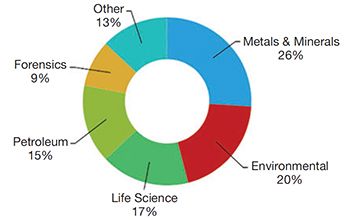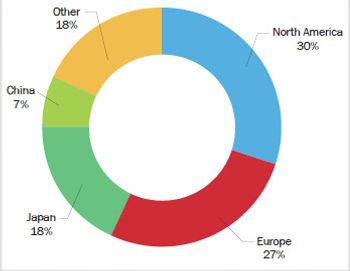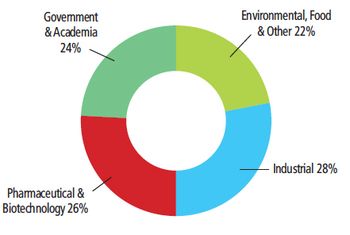
- Spectroscopy-05-01-2011
- Volume 26
- Issue 5
LC–MS Water Analysis
Liquid chromatography–mass spectrometry (LC–MS) is a very powerful analytical technique that combines two dimensions of separation techniques. It is finding a rapidly growing demand from water analysis applications due to the increasing need to monitor water for new potential contaminants at very low levels. Despite very strong continued growth in the area, competition is already fairly concentrated among the top several competitors.
Liquid chromatography–mass spectrometry (LC–MS) is a very powerful analytical technique that combines two dimensions of separation techniques. It is finding a rapidly growing demand from water analysis applications due to the increasing need to monitor water for new potential contaminants at very low levels. Despite very strong continued growth in the area, competition is already fairly concentrated among the top several competitors.
LCâMS in water analysis - 2010 vendor share.
Most of the parameters normally considered in the evaluation of various types of water, such as drinking water, wastewater, and surface water, include such measurements as pH, conductivity, dissolved oxygen, and so forth. Frequently more specific analyses are required, such as for chlorine, total organic carbon (TOC), sodium, and turbidity, that often make use of ISE or optical-based analyzer systems, which are somewhat more complex systems but are still relatively basic instruments. Recently scientists and regulators have begun to become very concerned about other classes of potential water contaminants, such as viruses, pharmaceuticals, pesticides, and industrial chemicals, that may be harmful to humans or aquaculture in very low concentrations. LC–MS provides the specificity to both identify and quantify such complex and low-level compounds in water that much more basic instruments do not.
The market for LC–MS in water analysis applications has grown rapidly to more than $170 million in 2010, and it should continue to see strong double-digit growth over the next few years. Agilent, which is very strong in both high performance liquid chromatography (HPLC) and LC–MS, and also supplies HPLC systems to AB Sciex for its mass spectrometers, leads the market, and Waters is a strong second. Although AB Sciex is much more focused on life-science applications, it is still extremely strong in triple-quadrupole LC–MS, and its systems are often found in environmental analysis laboratories.
The foregoing data were extracted from SDi's market analysis and perspectives report entitled The Global Assessment Report, 11th Edition: The Laboratory Life Science and Analytical Instrument Industry, October 2010. For more information, contact Stuart Press, Vice President, Strategic Directions International, Inc., 6242 Westchester Parkway, Suite 100, Los Angeles, CA 90045, (310) 641-4982, fax: (310) 641-8851,
Articles in this issue
over 14 years ago
Productsover 14 years ago
Pittcon 2011 New Product Reviewover 14 years ago
Classical Least Squares, Part V: Experimental Resultsover 14 years ago
Close Enough: The Value of Semiquantitative Analysisover 14 years ago
Vol 26 No 5 Spectroscopy May 2011 Regular Issue PDFNewsletter
Get essential updates on the latest spectroscopy technologies, regulatory standards, and best practices—subscribe today to Spectroscopy.




